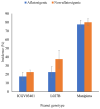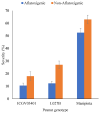Growth and Toxigenicity of A. flavus on Resistant and Susceptible Peanut Genotypes
- PMID: 36006198
- PMCID: PMC9414427
- DOI: 10.3390/toxins14080536
Growth and Toxigenicity of A. flavus on Resistant and Susceptible Peanut Genotypes
Abstract
Aflatoxin contamination poses serious health concerns to consumers of peanut and peanut products. This study aimed at investigating the response of peanuts to Aspergillus flavus infection and aflatoxin accumulation. Isolates of A. flavus were characterised either as aflatoxigenic or non-aflatoxigenic using multiple cultural techniques. The selected isolates were used in an in vitro seed colonisation (IVSC) experiment on two A. flavus-resistant and susceptible peanut genotypes. Disease incidence, severity, and aflatoxin accumulation were measured. Genotypes differed significantly (p < 0.001) in terms of the incidence and severity of aflatoxigenic and non-aflatoxigenic A. flavus infection with the non-aflatoxigenic isolate having significantly higher incidence and severity values. There was no accumulation of aflatoxins in peanut genotypes inoculated with non-aflatoxigenic isolate, indicating its potential as a biocontrol agent. Inoculations with the aflatoxigenic isolate resulted in the accumulation of aflatoxin B1 and G1 in all the peanut genotypes. Aflatoxin B2 was not detected in ICGV−03401 (resistant genotype), while it was present and higher in Manipinta (susceptible genotype) than L027B (resistant genotype). ICGV−03401 can resist fungal infection and aflatoxin accumulation than L027B and Manipinta. Non-aflatoxigenic isolate detected in this study could further be investigated as a biocontrol agent.
Keywords: aflatoxigenic; host plant resistance and susceptible; in vitro seed colonisation; non-aflatoxigenic.
Conflict of interest statement
The authors declare no conflict of interest.
Figures








Similar articles
-
Impact of simulated climate change conditions on Aspergillus flavus biocontrol effectiveness in peanut-based medium and peanut seeds.Int J Food Microbiol. 2025 Jan 30;428:110981. doi: 10.1016/j.ijfoodmicro.2024.110981. Epub 2024 Nov 17. Int J Food Microbiol. 2025. PMID: 39579524
-
Non-aflatoxigenic Aspergillus flavus as potential biocontrol agents to reduce aflatoxin contamination in peanuts harvested in Northern Argentina.Int J Food Microbiol. 2016 Aug 16;231:63-8. doi: 10.1016/j.ijfoodmicro.2016.05.016. Epub 2016 May 13. Int J Food Microbiol. 2016. PMID: 27220011
-
Application of Non-Aflatoxigenic Aspergillus flavus for the Biological Control of Aflatoxin Contamination in China.Toxins (Basel). 2022 Sep 30;14(10):681. doi: 10.3390/toxins14100681. Toxins (Basel). 2022. PMID: 36287950 Free PMC article.
-
Biotechnological advances for combating Aspergillus flavus and aflatoxin contamination in crops.Plant Sci. 2015 May;234:119-32. doi: 10.1016/j.plantsci.2015.02.009. Epub 2015 Feb 25. Plant Sci. 2015. PMID: 25804815 Review.
-
Aspergillus section Flavi and Aflatoxins: Occurrence, Detection, and Identification in Raw Peanuts and Peanut-Based Products Along the Supply Chain.Front Microbiol. 2019 Nov 22;10:2602. doi: 10.3389/fmicb.2019.02602. eCollection 2019. Front Microbiol. 2019. PMID: 31824445 Free PMC article. Review.
Cited by
-
Impacts of Temperature and Water Activity Interactions on Growth, Aflatoxin B1 Production and Expression of Major Biosynthetic Genes of AFB1 in Aspergillus flavus Isolates.Microorganisms. 2023 May 4;11(5):1199. doi: 10.3390/microorganisms11051199. Microorganisms. 2023. PMID: 37317174 Free PMC article.
-
Assessment of Maize Hybrids Resistance to Aspergillus Ear Rot and Aflatoxin Production in Environmental Conditions in Serbia.Toxins (Basel). 2022 Dec 19;14(12):887. doi: 10.3390/toxins14120887. Toxins (Basel). 2022. PMID: 36548784 Free PMC article.
References
-
- Raza A., Khan Z.H., Khan K., Anjum M.M., Ali N., Owais M. Evaluation of Groundnut Varieties for the Agro-Ecological Zone of Malak and Division. Int. J. Environ. Sci. Nat. Resour. 2017;5:1–4. doi: 10.19080/IJESNR.2017.05.555671. - DOI
-
- Onat B., Bakal H., Gulluoglu L., Arioglu H. The effects of row spacing and plant density on yield and yield components of peanut grown as a double crop in Mediterranean environment in Turkey. Turkish J. F. Crop. 2017;22:71–80. doi: 10.17557/tjfc.303885. - DOI
-
- Bakal H., Kenetli A., Arioglu H. The effect of plant density on pod yield and some agronomic characteristics of different growthtype peanut varieties (Arachis hypogaea L.) grown as a main crop. Turkish J. F. Crop. 2020;25:92–99. doi: 10.17557/tjfc.748671. - DOI
-
- Sylvanus U.J. Master’s Thesis. Ahmadu Bello University, Faculty of Science, Department of Biological Sciences; Zaria, Nigeria: 2014. Effect of Defoliation on The Growth and Seed Yield of Four Groundnut (Arachis Hypogaea L.) Cultivars.
-
- Mwatawala H.W., Kyaruzi P.P. An Exploration of Factors Affecting Groundnut Production in Central Tanzania: Empirical Evidence from Kongwa District, Dodoma Region. Int. J. Progress. Sci. Technol. 2019;14:122–130.
Publication types
MeSH terms
Substances
Grants and funding
LinkOut - more resources
Full Text Sources

